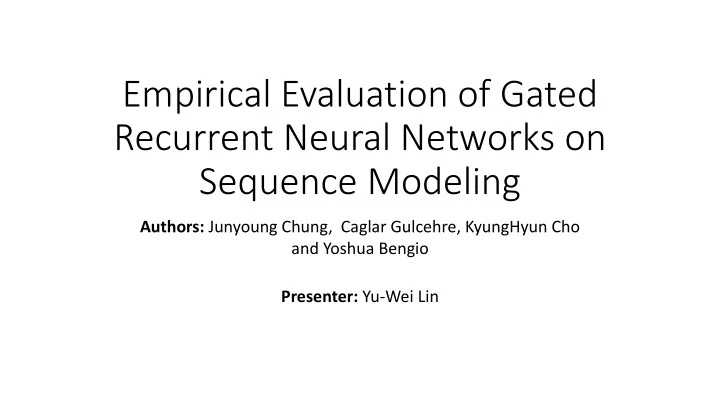

Empirical Evaluation of Gated Recurrent Neural Networks on Sequence Modeling Authors: Junyoung Chung, Caglar Gulcehre, KyungHyun Cho and Yoshua Bengio Presenter: Yu-Wei Lin
Background: Recurrent Neural Network • Traditional RNNs encounter many difficulties when training long-term dependencies. o The vanishing gradient problem/exploding gradient problem. • There are two approach to solve this problem: o Design use new methods to improve or replace stochastic gradient descent (SGD) method o Design more sophisticated recurrent unit, such as LSTM, GRU. • The paper focus on the performance of LSTM and GRU
Research Question • Do RNNs using recurrent units with gates outperform traditional RNNs? • Does the LSTM or the GRU perform better as a recurrent unit for tasks such as music and speech prediction?
Approach • Empirically evaluated recurrent neural networks (RNN) with three widely used recurrent units o Traditional tanh unit o Long short-term memory (LSTM) unit o Gated recurrent unit (GRU) • The evaluation focused on the task of sequence modeling o Dataset: (1) polyphonic music data (2) raw speech signal data. • Compare their performances using a log-likelihood loss function
Recurrent Neural Networks • x t is the input at time step t . • h t is the hidden state at time step t . • h t is calculated based on the previous hidden state and the input at the current step: o ℎ " = ∫(&' " + ) h t−1 ) • o t is the output at step t . o E.g., if we wanted to predict the next word in a sentence it would be a vector of probabilities across our vocabulary
Main concept of LSTM • Closer to how humans process information o Control how much of the previous hidden state to forget o Control how much of new input to take • The notion is proposed by Hochreiter and Schmidhuber 1997
Long Short-Term Memory (LSTM) • Forget Gate (gate 0, forget past) • Input Gate (current cell matters) • New memory cell • Final memory cell • Output Gate (how much cell is exposed) • Final hidden state
Main concept of Gated Recurrent Unit (GRU) • LSTMs work well but unnecessarily complicated • GRU is a variant of LSTM • Approach: o Combine the forgetting gate and input gate in LSTM into a single "Update Gate". o Combine the Cell State and Hidden State. • Computationally less expensive o less parameters, less complex structure • Performance is as good as LSTM
Gated Recurrent Unit (GRU) • Reset gate: determines how to combine the new input with the previous memory • If we set the reset to all 1’s and update gate to all 0’s, the model is the same as plain RNN • Update gate: decides how much of the previous model memory to keep around • Candidate hidden layer • Final memory at time step combines current and previous time steps:
Advantage of LSTM/GRU • It is easy for each unit to remember the existence of a specific feature in the input stream for a long series of steps. • The shortcut paths allow the error to be back-propagated easily without too quickly vanishing o Error pass through multiple bounded nonlinearities, which reduces the likelihood of the vanishing gradient.
LSTMs v.s. GRU LSTM GRU Three gates Two gates Control the exposure of memory Expose the entire cell state to content (cell state) other units in the network Has separate input and forget Performs both of these operations gates together via update gate More parameters Fewer parameters
Model • The authors built models for each of their three test units (LSTM, GRU, tanh) along the following criteria: o Similar numbers of parameters in each network, for fair comparison o RMSProp optimization o Learning rate chosen to maximize the validation performance from 10 different points from -12 to -6 • The models are tested across four music datasets and two speech datasets.
Task • Music dataset o Input: the sequence of vectors o Output: predict the next time step of the sequence • Speech signal dataset: • Look at 20 consecutive samples to predict the following 10 consecutive samples • Input: one-dimensional raw audio signal at each time step • Output: the next time 10 consecutive step of the sequence
Result - average negative log-likelihood • Music datasets o The GRU-RNN outperformed all the others (LSTM-RNN and tanh-RNN) o All the three models performed closely to each other • Ubisoft datasets o the RNNs with the gating units clearly outperformed the more traditional tanh- RNN
Result - Learning curves • Learning curves for training and validation sets of different types of units o Top: number of iterations o Bottom: the wall clock time • y-axis: the negative-log likelihood of the model shown in log-scale. • GRU-RNN makes faster progress in terms of both the number of updates and actual CPU time.
Result - Learning curves Cont’d • The gated units (LSTM and GRU) well outperformed the tanh unit • The GRU-RNN once again producing the best results
Take ways • Music datasets o The GRU-RNN reached the inching better performance. o All of the models performed relatively closely • Speech datasets o The gated units well outperformed the tanh unit o The GRU-RNN produce the best results both in terms of accuracy and training time. • Gated units are superior to recurrent neural networks (RNNs) • The performance of the two gated units (LTM and RGU) cannot be clearly distinguished.
Thank you !
Recommend
More recommend